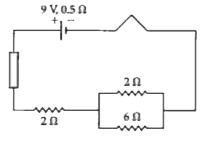The series combination of two batteries both of the same emf 10 V, but different internal resistance of 20Ω and 5Ω is connected to the parallel combination of two resistors 30Ω and RΩ . The voltage difference across the battery of internal resistance 20Ω is zero, the value of R(in Ω) is __________.
To solve the problem, we need to analyze the circuit step by step, focusing on the series combination of the batteries and the parallel combination of the resistors.
1. Understanding the Circuit:
- We have two batteries in series, both with an emf of 10V.
- The internal resistances are R1=20Ω and R2=5Ω.
- These batteries are connected to a parallel circuit consisting of a 30Ω resistor and an unknown resistor R.
2. Voltage Across the First Battery:
- The problem states that the voltage difference across the battery with internal resistance 20Ω is zero. This means that the entire voltage drop across this battery is equal to its emf.
- Therefore, we can write:
V1=0⟹E1−IR1=0⟹10−I⋅20=0
- Solving for I:
I⋅20=10⟹I=1020=0.5A
3. Voltage Across the Second Battery:
- Now, we can find the voltage across the second battery using the current I we just calculated:
V2=E2−IR2=10−0.5⋅5
- Calculating V2:
V2=10−2.5=7.5V
4. Applying Kirchhoff's Current Law:
- Since V2 is the voltage across the parallel combination of 30Ω and R, we can apply Kirchhoff's Current Law (KCL):
I=I1+I2
- Where:
- I1=V230=7.530
- I2=V2R=7.5R
- Substituting these into KCL gives:
0.5=7.530+7.5R
5. Solving for R:
- First, calculate I1:
I1=7.530=0.25A
- Now substitute I1 back into the KCL equation:
0.5=0.25+7.5R
- Rearranging gives:
0.5−0.25=7.5R⟹0.25=7.5R
- Cross-multiplying gives:
0.25R=7.5⟹R=7.50.25=30Ω
Final Answer:
The value of R is 30Ω.
---
- We have two batteries in series, both with an emf of 10V.
- The internal resistances are R1=20Ω and R2=5Ω.
- These batteries are connected to a parallel circuit consisting of a 30Ω resistor and an unknown resistor R.
- The problem states that the voltage difference across the battery with internal resistance 20Ω is zero. This means that the entire voltage drop across this battery is equal to its emf.
- Therefore, we can write:
V1=0⟹E1−IR1=0⟹10−I⋅20=0
- Solving for I:
I⋅20=10⟹I=1020=0.5A
- Now, we can find the voltage across the second battery using the current I we just calculated:
V2=E2−IR2=10−0.5⋅5
- Calculating V2:
V2=10−2.5=7.5V
- Since V2 is the voltage across the parallel combination of 30Ω and R, we can apply Kirchhoff's Current Law (KCL):
I=I1+I2
- Where:
- I1=V230=7.530
- I2=V2R=7.5R
- Substituting these into KCL gives:
0.5=7.530+7.5R
- First, calculate I1:
I1=7.530=0.25A
- Now substitute I1 back into the KCL equation:
0.5=0.25+7.5R
- Rearranging gives:
0.5−0.25=7.5R⟹0.25=7.5R
- Cross-multiplying gives:
0.25R=7.5⟹R=7.50.25=30Ω
The value of R is 30Ω.
Topper's Solved these Questions
Similar Questions
The series combination of two batteries, both of the same emf 10 V, but different internal resistance of 10Ω and 5Ω is connected to the parallel combination of two resistors 30Ω and RΩ . The voltage difference across the battery of internal resistance 10Ω is zero, the value of R (in Ω ) is : _________.
View SolutionThe series combination of two batteries, both of the same emf 10 V, but different internal resistance of 10Ω and 5Ω is connected to the parallel combination of two resistors 30Ω and RΩ . The voltage difference across the battery of internal resistance 10Ω is zero, the value of R (in Ω ) is : _________.
View SolutionThe series combination of two batteries, both of the same emf 20 V, but different internal resistance of 10 Ω and 2 Ω , is connected to the parallel combination of two resistors 10 ohm and RΩ . The voltage difference across the battery of internal resistance 10Ω is zero, the value of R(∈Ω) is _________.
View SolutionThree resistors of 1Ω,2Ωand3Ω are connected in parallel. The combined resistance of 3 resistors should be
View SolutionA cell of e.m.f. 2 V and internal resistance 1.2 Ω is connected to an ammeter of resistance 0.8 Ω and two resistors of 4.5 Ω and 9 Ω as shown in Fig.
find : the potential difference across the 4.5 Ω resistor.
View SolutionIn the circuit diagram given below, a cell of 9 V and internal resistance of 0.5(Ω) is connected across a resistor A of 2Ω in series and two resistors of 2Ω and 6Ω in parallel.

Find
The potential difference across the terminals of the cell.
View SolutionFig. shows two resistors A of 4Ω and B of 6 Ω joined in series to a battery of e.m.f. 12 V and internal resistance 2 Ω . Calculate :

the current in circuit,
View SolutionTwo resistors of resistances 2Ω and 6Ω are connected in parallel. This combination is then connected to a battery of emf 2 V and internal resistance 0.5Ω. What is the current flowing through the battery ?
View SolutionA battery of e.m.f. 15 V and internal resistance 3Ω is connected to two resistors 3 Ω and 6 Ω connected in parallel. Find :
the current in 6 Ω resistor.
View SolutionA battery of e.m.f. 15 V and internal resistance 3Ω is connected to two resistors 3 Ω and 6 Ω connected in parallel. Find :
the current in 3 Ω resistor,
View Solution
